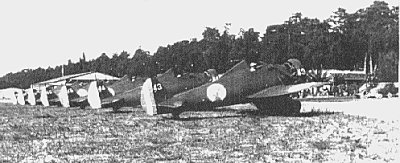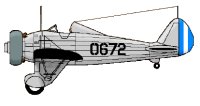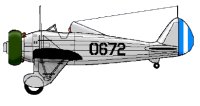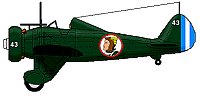
Boeing P-26A Peashooters of the Guatemalan Air Force, 1943
Photo FAG/Fransisco Rizzo

by Mario Overall
The direct descendant of the Boeing model 208, called P-26, was a strange mixture of old and new technology. It was Boeing's first monoplane fighter production and the Army's first fighter being entirely constructed of aluminum. The P-26, was also, the last Boeing fighter production, and the last Army Fighter with open cockpit, fixed landing gear and arresting cables on the wings.
The P-26A first flown on January 10th 1934, but shortly after, the prototype was grounded again due to an accident in which one of the wings broke when the test pilot was trying to land the plane. After the accident, Boeing installed a set of arresting cables on each wing, to keep the wing structure weightless and at the same time strong. The fixed landing gear was a solution to avoid complicated and heavy retractable landing gear systems under the fuselage. This fixed landing gear was not so aerodynamic, and generated a considerably amount of drag, but was compensated by the light weight of the plane and the powerful Pratt & Whitney R-1340-27 "Wasp" engine.
Another major problem for Boeing was that the plane had a dangerous minimum landing speed of 82.5 mph. The Army pilots considered the plane as a "Hot Machine" and in several occasions, some of them had a hard time trying to keep under control the plane during landings. In the worst cases, they ended with the plane out of the runway and the engine smashed on the ground or with the landing gear broken. Two months after entering service, Boeing and the Army began experiments with a couple of small flaps installed behind each wing aileron. With this modification, the landing speed was reduced to 73.2 mph, but the pilots remained having the same problems to keep the plane under control during landings.
After the production ended in June 30 1934, Boeing had delivered 111 P-26s to the Army, and they remained flying until the late 1940.

A P-26A Peashooter of the Guatemalan Air Force, 1957.
Photo FAG/Mario Overall
The U.S. Army years :
The first batch of P-26A was delivered to the Army Air Corps, 20th Pursuit Squadron, based at Barksdale Field, Louisiana in the early 1934. Soon, another batch was delivered to the 1st Pursuit Group based at Selfridge Field, Michigan, and another to the 17th Pursuit Group based at March Field, California. By mid 1938, the 18th Pursuit Group, based at Wheeler Field in Oahu Hawaii, received a batch of 11 P-26. Later that same year, the 15th Pursuit Group was disbanded and its P-26 and Curtiss P-36 were transferred to the 18th Pursuit Group in Hawaii. By the time when Pearl Harbor was attacked by the Japanese, only eleven P-26s remained airworthy with the 18th Pursuit Group. Six of them were destroyed and one was damaged during the attack.
On the early 1939, the 17th Pursuit Group was transferred from California to Albrook Field Panama. There, the group became the 16th Pursuit Squadron. Later, that same year, they were transferred again: This time to the 37th Pursuit Group who flew them until 1941, after that, the group was re equipped with the newer P-40B.
After 1941, some of the P-26s conformed the 32nd Pursuit Group, and the rest were stored in crates and placed in a hangar at Albrook Field. By the end of that year, some of the planes were re assembled and transferred to the Philippines Army, where they conformed the 3rd Fighter Squadron. Soon, two kills were claimed by two Filipino P-26 pilots. The victims were two Japanese A6M2 Zeke. By the end of 1941, only nine P-26s were in "fair good condition" but stored in Albrook Field.

A P-26A Peashooter over Guatemala City, 1945.
Photo FAG/Mario Overall
The Guatemalan Air Force Service :
In November 1942, the Guatemalan government was interested in acquiring seven of the nine remaining P-26s. By the time there was a U.S. congressional prohibition on selling "lethal" armament to the Latin American Countries (except Brazil and Mexico), but the U.S. Army was very interested in getting rid of the obsolete planes, and reported them as Fairchild PT-26 "Trainers" on the sale documents. In the early 1943, finally, four P-26s were delivered to FAG, and two more in May. The planes were officially handed over by the end of that month. One last plane was delivered crated, for spares, but the FAG mechanics quickly made it airworthy.
The planes gained the serial numbers 42 to 49, and an unusual paint scheme was applied to all of them, including a badge on the fuselage showing a Mayan cacique. Shortly after the final delivery, one of the planes ( FAG 42 ) was damaged beyond repair while taxiing prior to take off. The P-26 stumbled into a small rut on the taxiway and the right landing gear collapsed. It was being piloted by Lt. Rene Sarmiento, who was one of the few qualified FAG pilots to fly the Peashooters.
The Peashooters became the FAG's "Pride and joy" and the classic line ups on La Aurora main ramp were usual upon arriving dignitaries. Although, the lack of qualified pilots increased and the planes were seldom flown. By 1945, only three FAG pilots were P-26 certified.
During the Castillo Armas liberation forces invasion on June 1954, none of the P-26 were used to repel the CIA's F-47 attacks, mainly due to the lack of IFR capabilities of the type and bad weather over the attacked areas. It is worth mentioning that the only IFR capable planes in FAG service at that time were the T-6, but the navigation instruments of this planes were out of order due to the lack of spares. On June 19 1954, two P-26s were destroyed on the ground during an attack to La Aurora Air Base, and the next day, another P-26 crashed near San Pedro Pinula while conducting a surveillance flight around the Guatemala city. The pilot, Maj. Pedro Granados, survived the crash.
By July 1954, the surviving Peashooters went through another change in their painting schemes, and were re-serialled with a very strange numeration. (After the overthrown of the Arbenz government, all FAG aircraft were re-serialled, being used four digits on each serial number instead of two.) At this time, only five pilots were P-26 certified, but, somehow, they avoided to fly the planes, arguing that the P-26 was unsafe to fly, specially on landings.
In the late 1956, only two P-26 remained airworthy, those being FAG 0672 and FAG 0816. Later one of them was acquired by the Planes of Fame museum of Chino, California, and the other by the Smithsonian Air & Space museum. The one with the Planes of Fame Museum is flyable to this date.

Boeing P-26A Peashooter
F.A.G. early scheme 1943

Boeing P-26A Peashooter
F.A.G. scheme 1945-46

Boeing P-26A Peashooter
F.A.G. scheme July 1954

Boeing P-26A Peashooter
F.A.G. scheme 1957
The Boeing P-26, Aircraft in profile. by Peter M. Bowers
Boeing P-26 Peashooter, Air International. by Robert F. Dorr
Central American and Caribbean Air Forces by Dan Hagedorn
Interviews:
Col. Rene Sarmiento (June 1997)
Col Ruben Zuchinni (June 1997)
